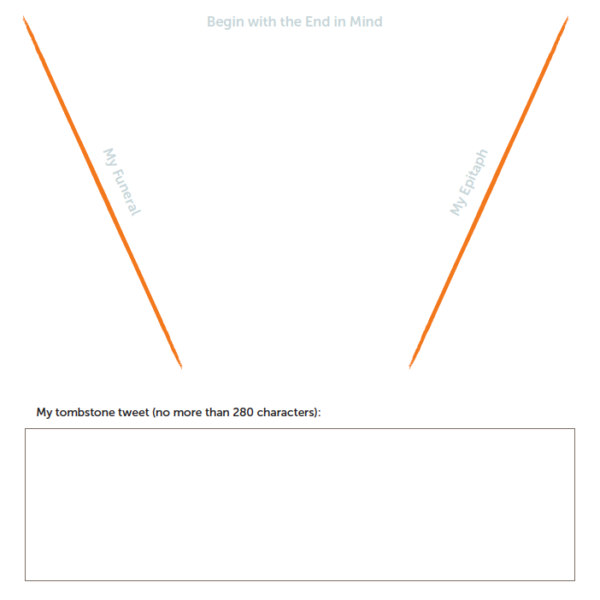Personal Vision Frame
Purpose/Objective
Help participants understand the concepts of LifeCall and LifeCore before they start to unpack it personally.
How It Works
BIG IDEA: When we are clear on our convictions it enables us to move flexibly in the world without compromising.
- Give the Coconut vs Peach metaphor by Erwin McManus.
- Illustration point: When you don’t know what is important to you, you won’t let go of anything for fear that it may be important eventually. This makes for a hard exterior (what people get from you) and a soft, uncertain interior (what you deal with internally).
- If LifeCall is who you are and what you’re called to do, LifeCore is the deepest motivations or values that guide your behavior.
- LifeCall is what you can’t help but do and LifeCore is what you can’t live without. Together they are the support beams of your Personal Vision Frame.
- “If you don’t know who you are called to be you will be whatever people pay you to be.” – Dave Rhodes.
Where to Find This Tool
Name
Location
Coaching Video
Purpose/Objective
Turn Inventory and Interpretation into Inscription around the LifeCore statement of the personal Vision Frame.
How It Works
BIG IDEA: Your values are what you love about what you love.
- Pause to pray before beginning this exercise. It is often the hardest part of the whole journey.
- Have everyone pull out the following tools for easy access:
- Life Discovery Grid
- Life Drifts Grid
- Passion Circle Inventory
- Ability Circle Inventory
- Context Circle Inventory (if you have completed this circle in the delivery schedule you have chosen)
- Invite one participant to populate their funnel step by step in front of the group, as you prompt them, as a helpful example. You will want to use a whiteboard that it visible to the entire group.
- At the same time, have each participant complete their own LifeCore Funnel in their workbook.
- Funnel Population Components:
1. Name Meanings – from Passion Circle Inventory
2. Chapter titles & dates – from Life Discovery Grid
3. Life lies & truth – from Life Drifts Grid
4. Personality (colors & titles) – Ability Circle Inventory
5. Things that offend most – Passion Circle Inventory
6. Passions/Burdens from Passion Circle Inventory - Here are a few questions that may help unearth underlying motivators:
- What are three biggest pain points in your life? What came out on the other side of them and why is that important to you?
- What motivates you most deeply?
- Who are you when you are at your best?
- What convictions to you see appear consistently?
- What is always true about you no mater what you are doing, where you are and who you are with?
- Mine out at least two LifeCore values with your volunteer participant in front of the rest of the group to demonstrate to others how they can mine out their own LifeCore statements
- Bring themes into the 4 boxes at the bottom of the funnel based on inventory and answers to above questions.
- Ask volunteer participant if there is anything missing from what is represented in boxes.
- Begin word smithing into One Word, Two Word or Short Phrase.
- Find rhythms and cadence that is consistent.
- Ask if this stirs excitement, meaning and passion.
- You will not most likely not be able to complete all 4 values in session. Try to get to 2 that are 60-80% articulated.

Context-Specific Tips
-
Weekly Cohort
Prior to this session, ask for one volunteer ahead of time. You may have a sense of who will be able to process aloud well or someone the Spirit of God nudges you to ask.
Where to Find This Tool
Name
Location
Coaching Video
Purpose/Objective
Help participants mine out and articulate the most important values and motivations that answer the big “why” question of their life.
How It Works
BIG IDEA: Your values aren’t what you do; your values are what characterize everything you do – the WHY that reveals the WHO in all that you do.
- Explain to participants the three different forms that a LifeCore can take. Let them know they will have a few hours out of session to work through it on their own.
- 1 word
- 2 words
- Short phrase
- Explain how the “because statements” and the “demonstrated by” statements
work to make the value unique.- Because statement: the “why behind their why”, helping bring further language to why that value is important to them.
- Demonstrated by: answers how value plays out and takes shape in the everyday of life. This is a helpful but not crucial component to the LifeCore articulation.
- Offer examples for further guidance from the examples in the workbook and your own.
- Have participants record their final or “best I can say it today” articulation onto the Vision Frame Reporting Sheet in preparation for sharing with the group.
Context-Specific Tips
-
Accelerator
This is one of the crucial times table coaches will be needed.
-
Weekly Cohort
If you’re doing this on a week-to-week journey, carve some time out in your schedule to meet individually with people in your cohort.
Where to Find This Tool
Name
Location
Coaching Video
Purpose/Objective
Allow participants to not only share their core motivations and values, but to continue to learn the skill of spiritually listening to other people’s interpretations and to gain further insight into their own LifeCore
How It Works
BIG IDEA: Three-Way Listening opportunity: 1. To the Holy Spirit for counsel and conviction; 2. To one another for encouragement and insight; and 3. To ourselves for awareness and response.
- Each participant shares their refined LifeCore.
- Give each participant about 7 minutes to share (set a timer).
- Remind them of three-way listening and how important it is in this moment.
- Reiterate the commitment to being a safe space for one another.
- Allow for a few minutes after each person shares for encouragement and coaching. This is an opportunity for the table group and coach or cohort and coach to provide helpful refinement for this stage of the process.
Where to Find This Tool
Name
Location
Coaching Video
Purpose/Objective
Help participants turn the stunning clarity they have personally with the two words of their One Thing into a short phrase that they can use to articulate their calling to others.
How It Works
BIG IDEA: Your LifeCall statement gives meaningful language to what you can’t help but do in all that you do.
- Share the Ernest Hemingway illustration:
- “For Sale: Baby’s shoes. Never worn.”
- Give the Hemingway challenge to the participants:
- Each participant has 6 minutes to come up with 6 words that explain their One Thing as a calling statement. The goal is clarity with easy accessibility.
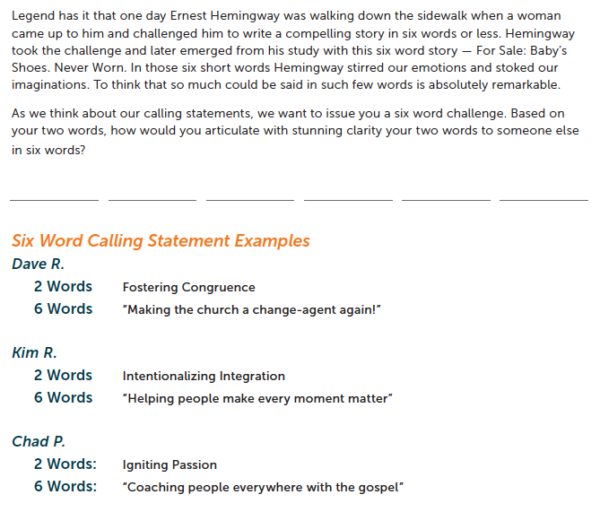
Context-Specific Tips
-
Accelerator
Optional: Show a video (about 12 minutes in length) to emphasize the creativity that limitations can bring: Embrace the Shake
VIEW -
Weekly Cohort
Participants will want to loosen time constraints after this session, to process through their initial articulation and bring further thought and clarity to expressing their LifeCall statement in six words.
-
1:1 Retreat
Introduce the 6-Word exercise with the Ernest Hemingway story. Feel the freedom to quickly declare LifeCall with the best words without being tied to word count.
VIEW
Where to Find This Tool
Name
Location
Coaching Video
Purpose/Objective
Help participants fill out their six word calling statement with six more words, emphasizing the how of their Life Call.
How It Works
BIG IDEA: Adding six more words can help you clarify your LifeCall with the: how, where, why or with whom.
- Give participants 6 minutes to find 6 more words that help fill out their LifeCall statement.
- This is a continuation of limitation for the sake of creativity.
- Remind participants they will be able to remove the time limitation after this exercise to give more thought and revision to their LifeCall statement.
- After you you finish this exercise offer the following coaching:
- Participants will now want to land on a completed LifeCall statement that is no longer than 15 words to maintain both clarity and portability.
- Direct participants to the examples given in the workbook for further guidance.
- Share your complete LifeCall statement and speak to how the concise clarity helps to inform and direct the everyday of your life.
- Ask participants to record their “best way I can say it today” articulation on the Vision Frame Reporting sheet, paper or digital form. This is the document that spells out the supporting beams of their Personal Vision Frame.
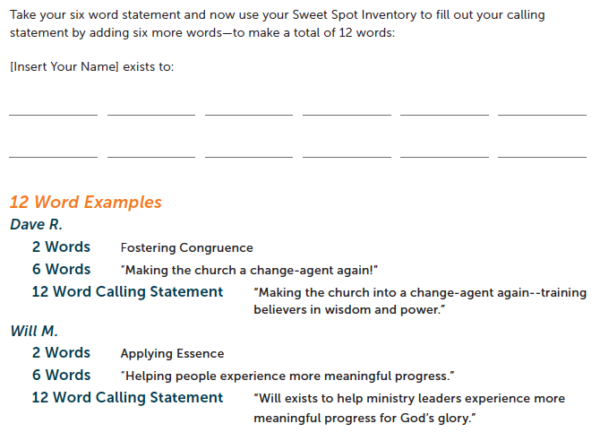
Context-Specific Tips
-
Accelerator
Participants will want to loosen time constraints after this session, to process through their initial articulation and bring further thought and clarity to expressing their LifeCall statement in twelve words.
-
Weekly Cohort
Participants will want to loosen time constraints after this session, to process through their initial articulation and bring further thought and clarity to expressing their LifeCall statement in twelve words.
Where to Find This Tool
Name
Location
Coaching Video
Purpose/Objective
To finalize their LifeCore and LifeCall statements.
How It Works
BIG IDEA: This is the synthesis of Journey 1 that offers stunning clarity on one page.
- As a reminder from LifeCall exercise, take the pressure off from the LifeCall statement to be exactly 12 words. Encourage participants to use no more than 15 words to finalize their LifeCall statement so it is portable and memorable.
- Give participants time as needed to finalize their LifeCall and LifeCore statements, whether they have already documented their “best way I say this today” statements here or still need to do so.
- Break into smaller groups to be able to share with a few people and receive feedback prior to finalizing for the celebration next session.
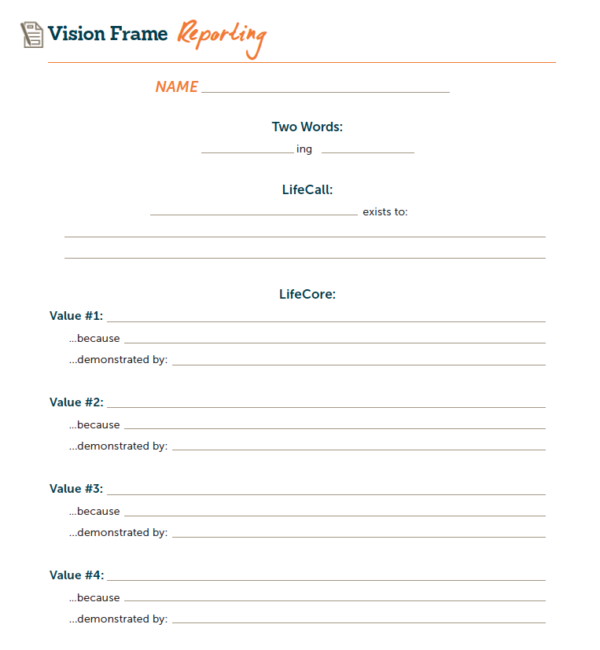
Context-Specific Tips
-
Accelerator
Regardless of the delivery order for LifeCall and LifeCore in your context, you will want to offer a moment of sharing/coaching when the Vision Frame Reporting sheet is completed.
-
Weekly Cohort
Regardless of the delivery order for LifeCall and LifeCore in your context, you will want to offer a moment of sharing/coaching when the Vision Frame Reporting sheet is completed.
Where to Find This Tool
Name
Location
Coaching Video
Downloads
Purpose/Objective
Encourage participants to celebrate the clarity they have found throughout Journey 1 by sharing their LifeCall and LifeCore statements.
How It Works
BIG IDEA: Your masterful design and purpose is worth celebrating!
- Place each participant’s name in a jar.
- Pull participants names out, one name at a time.
- Have the person you’ve pulled out come up and share their LifeCall and LifeCore.
- Have the group count down each person (from 5, 4, 3, 2, 1)…and clap for the person who is about to share, even before they say a word,
- Celebrate again after each person has shared their LifeCall and LifeCore.
- Let the person who shared pull out the next name.
- Continue the process until everyone has shared.
Context-Specific Tips
-
Accelerator
“This is Me” inspirational video as an option at the front end of celebration to set the stage and tone. If you have timid participants, offer to stand with them as they share.
VIEW -
Weekly Cohort
“This is Me” inspirational video as an option to send to weekly participants in post-session email.
VIEW
Where to Find This Tool
Name
Location
Coaching Video
Purpose/Objective
To help participants connect the dots of where they’ve been so far in Journey 1 with where they are about to go in Journey 2.
How It Works
BIG IDEA: The tendency we have as humans is to expand our call to fit our life. What God is asking us to do is to change our life to fit our call.
- Share the John Scolinos illustration—How wide is home plate? 17”
- Demonstrate how inscribing the 4 parts of the Younique Vision Frame—LifeCall, LifeCore, LifeSteps and LifeScore helps us define the 17” of our personal home plate.
- Review the components of the Vision Frame: LifeCall, LifeCore, LifeScore, LifeSteps, LifePlan
- Differentiate the two Journeys with this analogy: In Journey 1 the Vision Frame was like a mirror to clarify identity. In Journey 2 the Vision Frame serves more as a window to envision the future.

Where to Find This Tool
Name
Location
Purpose/Objective
To ground the experience of Journey 2 in a biblical framework that describes not only the possibility of the end destination but the emotional tension that lies in between now and then.
How It Works
BIG IDEA: Most people confuse dreams with fantasy. Dreams are rooted in reality. Fantasies deny reality.
- Read Jeremiah 29:4-14
- Set the passage in its context and tell the story behind it.
- Differentiate between dream and fantasy.
- Emphasize the fact that God has a dream and a plan for His people and that this Journey we will be working on identifying both of these things.
- Explain to the participants that this Journey of identifying God’s Dream and plan for our lives will begin and end with a confession – a confession of “what is” (sin—where we are hitting and not hitting the mark).
and a confession of “what will be” (faith—a plan). - Reiterate that a plan is simply a confession of faith. In Journey 2 this confession of faith will be a 3 year LifePlan.
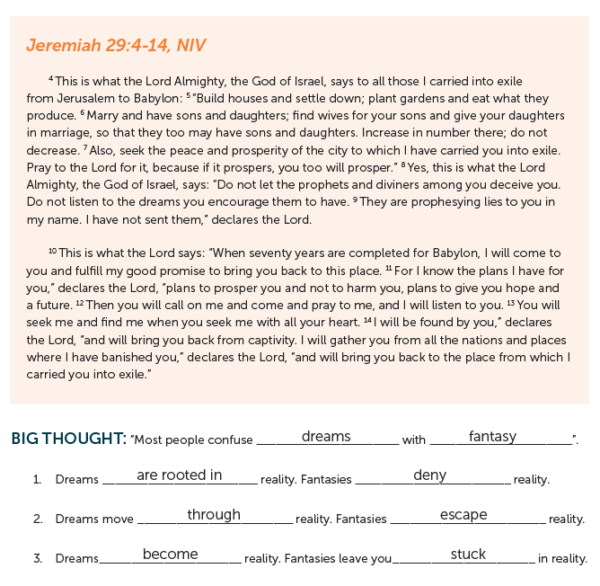
Where to Find This Tool
Name
Location
Coaching Video
Purpose/Objective
To help participants assess and confess how the various domains of their life are going (Personal, Family, Faith, Vocation)—where they are hitting and not hitting the mark.
How It Works
BIG IDEA: We need “brutiful” honesty AND a deep belief that in the end we will win. This is confession and faith.
- Share the Stockdale Paradox Illustration.
- From John Collins’ book Good to Great – an interview with Admiral John Stockdale
- Stockdale was highest ranking military officer captured in Vietnam war, tortured for 20 years
- Q: How did you survive? A: Never lost sight that I would survive and this would be defining life moment.
- Q: Who didn’t make it out? A. Optimists who believed we would be out in the short term and as holidays came and went they lost heart.
- Those that survived embraced the paradoxical reality: the discipline to embrace brutal facts of current reality yet never lost sight that in the end they would win.
- In the Christian worldview we call this confession (declaring what is) and faith (declaration of what is not but what will be)
- Walk through the Life Domains Assessment (from Tom Patterson) worksheet with participants, giving examples as you go.
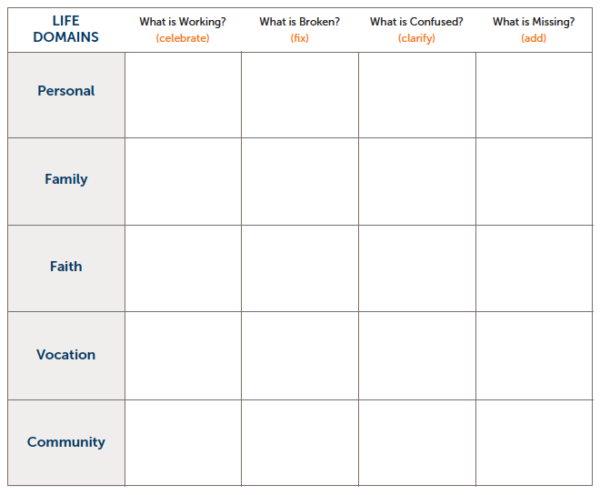
- Participants have 20 minutes to work through the assessment. (Show them the two example pages in the Participant Guide if they need help)
Context-Specific Tips
-
1:1 Retreat
Get an inventory of why the client is here and the questions they are seeking to answer.
VIEW
Where to Find This Tool
Name
Location
Coaching Video
Purpose/Objective
To help participants hone in on the most important reflections from the Life Domains Assessment through personal reflection, sharing and listening to the reflections of others.
How It Works
BIG IDEA: Opportunity for three-way listening: to honor God, to honor each other and to learn more about ourselves.
- Give participants 5 minutes to fill out the Reporting and Listening worksheet: 3 reflection, 2 struggles, 2 celebrations
- Have participants write down their three biggest reflections.
- Use the remainder of the session for group sharing, giving everyone about 5 minutes.
- Model the format and personal vulnerability for sharing ahead of time by sharing from your own life.
- Remind participants that beginning in a place of reality in their life is the best way to design their life.
Context-Specific Tips
-
Weekly Cohort
Have participants come prepared to the session with the Reporting and Listening sheet filled out. This will maximize your sharing time especially if you have a larger cohort.
Purpose/Objective
To introduce the LifeScore part of the Vision Frame, creating a personal dashboard for consistent evaluation of a wholistic life, based on Storylines instead of Domains.
How It Works
BIG IDEA: In a fluid world, many people are still living DIS-Integrated lives. Our goal is to live integrated lives because we are more than one thing.
- Explain that the LifeScore part of the vision Frame answers the question, “When am I successful?”
- Use the teaching to pivot from Domains to Storylines.
- Use the Categories of Health, Love, Work and Play to help participants begin thinking about their specific Storylines. Each of these are spiritual as they are all areas we can honor God and help others.
- Share your 4 Storylines and how you arrived at naming them.
- Explain the worksheet they’re going to work on.
- Give participants 20 minutes to brainstorm the names of their storylines and to sketch out a picture of each one of them.
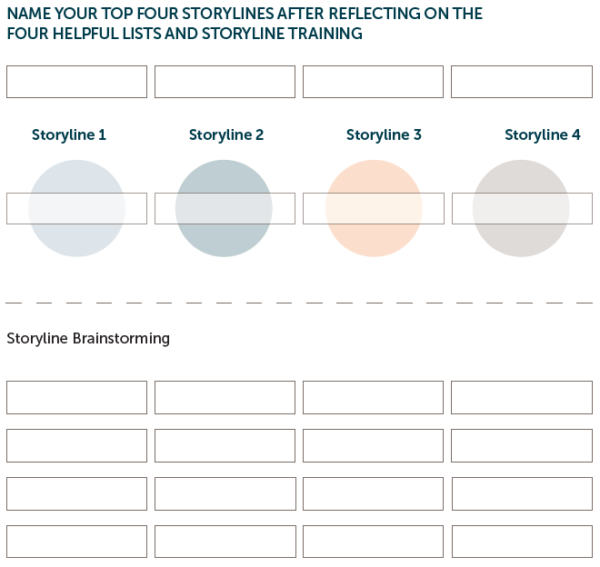
Context-Specific Tips
Where to Find This Tool
Name
Location
Coaching Video
Purpose/Objective
To help participants continue to shape and concretize their Storylines as they share their 4 Storylines with the group and listen to the Storylines of others.
How It Works
BIG IDEA: Opportunity for three-way listening: to honor God, to honor each other and to learn more about ourselves.
- Give each participant time to share his or her Storylines.
- Each person should share their Storylines in 3-4 minutes.
- Give the group one minute to ask questions after each person shares his or her storylines.
Where to Find This Tool
Name
Location
Purpose/Objective
To redefine success and create a Biblical framework for people to quickly assess what season each of their Storylines are currently in, within the great story that God is writing of their life, and press in to meet God in whatever season that is. This reminds us what we are doing best flows out of who we are becoming.
How It Works
BIG IDEA: Spiritual maturity is not about how well you are doing or feeling; it’s about GOING TO GOD despite how you are doing or feeling.
- Use the Psalm Spirituality teaching to reframe a biblical understanding of success and faithfulness with our lives.
- Use Walter Bruegemann’s interpretation of the Psalms— dividing the Psalms up into either Orientation, Disorientation or Reorientation to establish the different realities and seasons of our Storylines and how it is possible to be faithful in each season.
- Psalm Examples: Orientation: Psalm 8:1-4; Disorientation: Psalm 51:1-6; Reorientation: Psalm 40:1-3
- Transition Bruegemann’s language of Orientation, Disorientation and Reorientation to Thriving, Surviving and Reviving to help us assess where we are with each story line.
- Demonstrate how it is possible to be thriving in one Storyline and just surviving in another—demonstrating the nuance of being able to describe and evaluate our lives in each area. Everybody wants a great story but not a struggle. Part of any growth story of any human being includes all three of these stages.
- Explain how collectively this creates a dashboard to see all 4 storylines at once and ask yourself regularly, “How am I?”
- Invite the participants to evaluate where each Storyline in their life is currently using the language of Thriving, Surviving and Reviving. Emphasize this is a spiritual practice.
Where to Find This Tool
Name
Location
Coaching Video
Purpose/Objective
To create space for participants to dream about “life long wins” in each of their Storylines.
How It Works
BIG IDEA: Who gets to win with their life because we win with our life?
- Remind participants of the cycle of mutual blessing we see in Jeremiah 29. Give a quick explanation of what a ‘Bucket List’ is for participants who may not know what it is.
- Reiterate the power of dreaming and explain how we are going to use the idea of a Bucket List to help participants dream about and name life-long wins in each Storyline of their life so that they are better able to orient their lives in that direction.
- Begin with the Worksheet and 5 suggested categories to get ideas going.
- Walk through your Bucket List and through the examples in the Participant Guide to help your group dream about their own Bucket List.
- Offer helpful filters for discerning if a dream is self-indulgent. Encourage them to see if one of these would apply to their life-win dream:
- Does this build intimacy/growth in my closest relationships?
- Does this renew any part of me in any way?
- Can this be multiplied to benefit/ bless others?
- Does this increase my faith and advance the gospel?
- Pray for your group as they enter a the time of brainstorming, inviting the Holy Spirit to help them identify life-long wins in each Storyline of their lives. Then give participants 20 minutes for an initial brainstorm on their worksheet.
- If you have 3rd quarter life stage participants, encourage them to record and highlight life dreams that have been fulfilled as a celebration of God dreams already realized. This will bring glory to God, affirm the life they have already lived as well as activate future dreaming. It also will be inspiring to the younger generations in the group.
- Bring everyone back together and help them process their time.
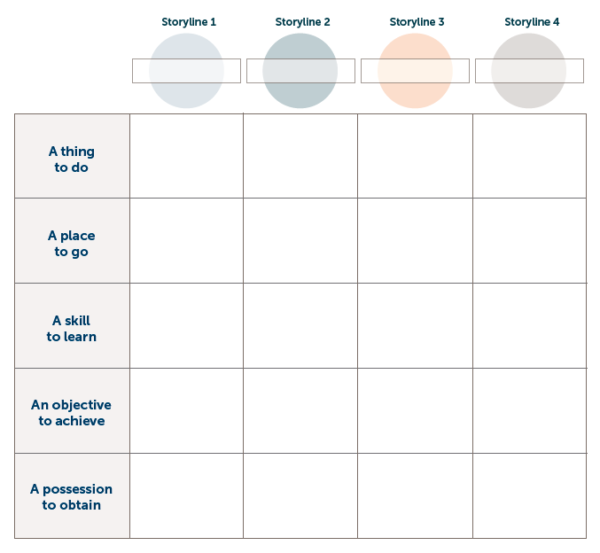
Context-Specific Tips
-
Weekly Cohort
Homework will be to dream up 10-15 life long wins for each storyline, adding to what was begin in session.
Where to Find This Tool
Name
Location
Coaching Video
Purpose/Objective
To help participants develop and concretize their Bucket Lists by sharing their Bucket Lists with each other.
How It Works
BIG IDEA: Opportunity for three-way listening: to honor God, to honor each other and to learn more about ourselves.
- Have each participants share their bucket list dreaming lists OR the top few favorite bucket list dreams from each storyline, whichever works better for your context.
- Invite listening participants to engage in active listening by sharing the things that stood out to them after each participant has shared.
Where to Find This Tool
Name
Location
Purpose/Objective
To transition from the LifeScore part of the Vision Frame to the LifeSteps portion of the Vision Frame.
How It Works
BIG IDEA; Life Steps are the one area of focus in each storyline, based on a current assessment of your roles, resources, replenishment rhythms in your life.
- Use the LifeSteps teaching to introduce the way LifeSteps articulate question “How do I do what God has called me to do?
- Define LifeSteps
- Explain that LifeSteps come from focusing on the following three areas:
- Roles – Role Map
- Resources – Resource Assessment (5 Capitals)
- Replenishment – Replenishment Rhythms
Where to Find This Tool
Name
Location
Purpose/Objective
To help participants identify and evaluate the different roles that they are currently stepping into inside their 4 Storylines.
How It Works
BIG IDEA: Most of us take time to think about WHAT we are doing. Few take time to think about HOW we are doing it and how well.
- Explain the importance of identifying the different roles that we are stepping into in our lives.
- Walk the participants through their Role Map worksheet one Step at a time.
- Have the participants place their Storylines in the first part of the Role Map.
- Have participants identify their 4 primary roles in each Storyline – taking one storyline at a time.
- Have participants identify their 3 secondary roles for each primary role of their Storylines. This is the double click into each primary role asking, “How do I uniquely step into/posture within this role?”
- Give illustrations around each development of the Role Map from your personal Role Map as well as the examples in the Participant Guide.
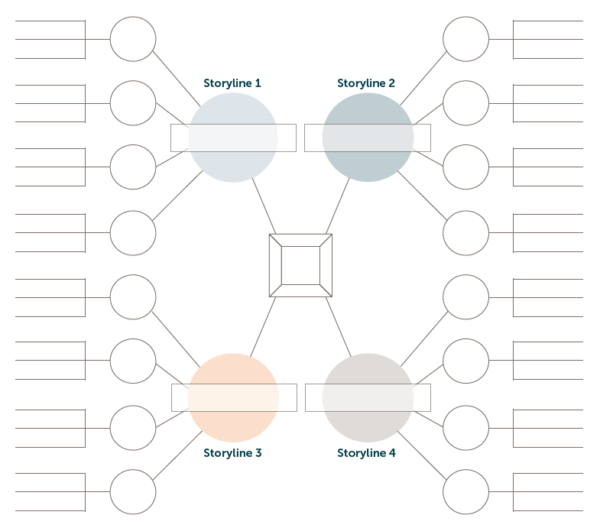
Context-Specific Tips
-
Weekly Cohort
The Role Map will take time. Encourage participants to continue what they began in session, taking one storyline at a time or first identifying all of their Primary Roles and then the Secondary Roles.
Where to Find This Tool
Name
Location
Coaching Video
Purpose/Objective
Help participants see that when it comes to living a life of impact, it’s more about their investment than their environment; and the Bible has a lot to say about investment.
How It Works
BIG IDEA Most people are asking God to change their environment when God is asking them to change their investment.
- Communicate that this is the second emphasis of the LifeSteps portion of the Vision Frame
- Read the passage from Matthew 25:14-30.
- Exegete text and land the three things that keep us from investing:
- Insecurity: We undervalue what we have been given.
- Fear: We overvalue what we could lose.
- Deception: We misvalue who God is.
- Optional Reflections: Highlight a few disturbing realities in this passage:
- People get different amounts – the justice is in what is given but in the reward.
- The guy who plays it safe is the Villain in this parable. Jesus eliminates neutral ground.
- Greatest danger in the kingdom is NOT people who fail but who do nothing.
- Explain the 5 Capitals and define their Currencies.
- The listed order of Capitals on the worksheet is intentional as it reflects kingdom principles. Reverse the order and you will see the priorities of our culture/world.
Context-Specific Tips
Where to Find This Tool
Name
Location
Coaching Video
Purpose/Objective
Help participants analyze, evaluate and reflect on their current resources and to bring greater alignment between their resources and their calling.
How It Works
BIG IDEA: What resources have you been given today that can be invested for tomorrow’s purpose? Recognize some of those resources may be in seed form.
- Give participants 17 hypothetical gold bars to list in their inventory worksheet, demonstrating the disbursement of their current capital, assessing where they have more and less capital in their lives. (5 minutes to do this)
- Have participants assume they are all “Good Servants”, meaning they will double their investments in the next 3 years. Now they have 34 bars. Where would they place them to best resource the LifeCall they identified in Journey 1?
- Have participants identify where the biggest gaps are located.
- Have participants finish the worksheet where they identify the capital they need to increase the most, as well as the investment that needs to be made to increase it.
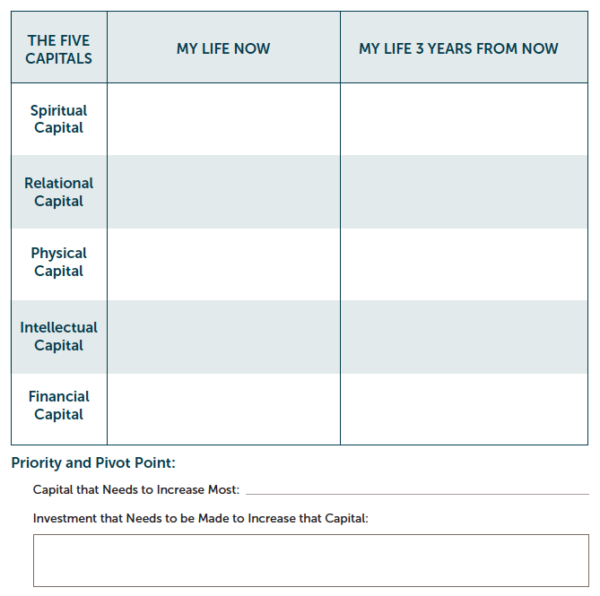
Where to Find This Tool
Name
Location
Coaching Video
Purpose/Objective
Help participants hone in on their own investment strategy for the future not only in reflecting and sharing, but in actively listening to the strategies of others.
How It Works
BIG IDEA: Opportunity for three-way listening: to honor God, to honor each other and to learn more about ourselves.
- Have each participant share their reflections from the gold bars exercise, sharing their biggest gaps, how they might want to bridge that gap and what possible strategies they can concentrate on going forward.
Where to Find This Tool
Name
Location
Purpose/Objective
Help participants see the Biblical pattern of working from a place of rest.
How It Works
BIG IDEA: Productivity is about seeing what God is doing in our rest and joining Him in our work. The secret to productivity is to rest, and out of rest to to work.
- Teaching Points:
- Recognize the pace of your life. Matt. 11:28-30 (Read in MSG translation)
- Recognize the pace of creation’s life. Gen. 1:3-5, 28, 31, 2:1-3. Part of the grace of Eden is the pace of Eden – each day beginning in rest.
- Recognize the pace of Jesus’ life – most productive person ever, what were his rhythms? Do you recover like Jesus? John 15.
- Participate in the replenishing rhythms of grace in your life.
Where to Find This Tool
Name
Location
Coaching Video
Purpose/Objective
To help participants identify some key areas of Work and Rest that they may need to emphasize in daily, weekly, quarterly and annual rhythms.
How It Works
BIG IDEA: Most of us need to have either rest or work redeemed in our life. Which is it for you? Where are our life rhythms out of line with rhythms of Eden?
- Individually, participants use the Rest-Work assessment worksheet to analyze, evaluate and reflect on their current Rest/Work patterns on a daily, weekly, quarterly and annual basis.
- Connect the rhythms here with Biblical ideas of day/night, Sabbath, Seasons and Feasts.
- Reiterate that we are designed for BOTH rest and work and that both allow us to fulfill our God-given purpose.
- Our greatest challenge is usually in the imbalance of these replenishment rhythms for a variety of reasons, one being our own life drifts. Great opportunity to connect back to J1 self awareness here.
- A point of differentiation: What feels like work to one person may feel like rest to another and vice versa. Encourage participants to have self awareness in what feels like rest and what feels like work to them.
- Have individuals quickly share their insights with one other person.
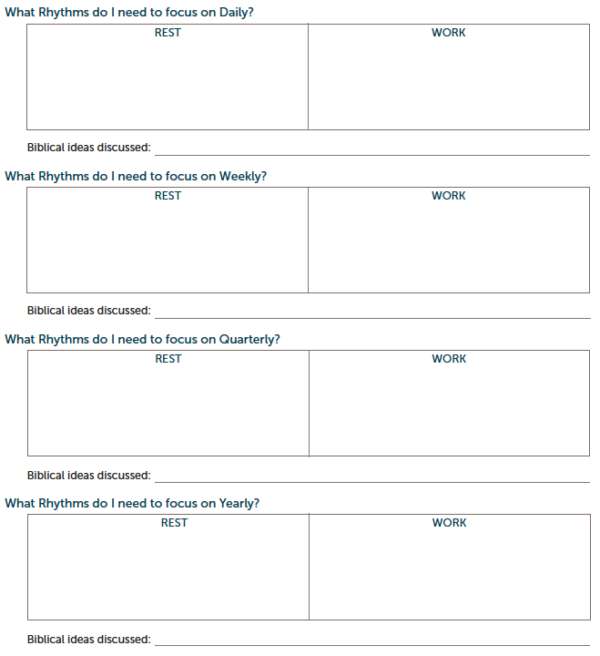
Context-Specific Tips
Where to Find This Tool
Name
Location
Coaching Video
Purpose/Objective
To help participants bring together the things that they have learned in each LifeSteps focus, and to bring those things to bear into each Storyline of their life.
How It Works
BIG IDEA: The grace God gives us forms the strategy for how we step into the dream He has been dreaming for us.
- Ask participants to take out their Role Map, their Resource Assessment and their Replenishment Rhythm worksheets.
- Have participants make general notes of places that stick out to them and where God has nudged them (ie: roles they need to step into, resources they need to re-allocate or increase, rhythms they need to emphasize). This step is an analysis of current conditions.
- Have participants use the LifeSteps Top Four Emphasis worksheet to either choose a role they want to step into, a resource they want to increase, or a rhythm they need to emphasize in each Storyline of their life, based on that current condition assessment.
- This one area of focus for each storyline is the first step.
- It will help to circle or use a different pen color when they write it in the appropriate box, so it will not be confusing in the next steps.
- Then show the connection of how choosing one major focus point in each Storyline will affect the other two “Rs” in that same Storyline, depending on how they are choosing to step into the one point of focus.
- Give participants time to fill out the entire worksheet.
- Preview that this one area of focus is something that will change every 90 Days in their Life Plan.
- Invite participants to share their insights and reflection with one or two others.
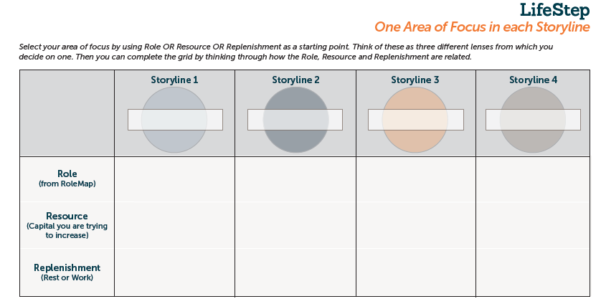
Context-Specific Tips
-
Accelerator
Johnny George’s video - to set up the completion of the 4th side of the Vision Frame, PRIOR to the LifeSteps worksheet. Highlight the convergence we see in this video as it relates to creating a life.
VIEW
Where to Find This Tool
Name
Location
Coaching Video
Purpose/Objective
To help participants engage the LifePlan part of their journey by beginning with the end in mind.
How It Works
BIG IDEA: An end of life vision gives us a clearer perspective for today’s living.
- Explain the Tombstone Tweet funnel to help participants picture their funeral, by engaging the following questions:
- Who’s at your funeral?
- What kinds of things are happening at your funeral?
- What does your epitaph read?
- What kind of things do you hope are happening after your funeral?
- Now that participants have placed themselves at their funeral, encourage them to come up with a tweet (no longer than 140 characters) that they hope would be the major contribution of their life. In other words, what are people saying about their life?
- Have participants write this out in the box on their worksheet.
- Encourage a couple of participants to share their tweet with the group.
